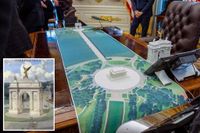Plans for a monumental new addition to Washington, D.C.’s skyline have emerged, as President Donald Trump appears poised to commemorate the United States’ 250th anniversary with a towering arch reminiscent of Europe’s most iconic triumphal monuments. Leaked images and social media posts over the past week have revealed detailed designs and scale models of what some are already calling the “Arc de Trump,” a project that could become a defining feature of the nation’s semiquincentennial celebrations in 2026.
The first hints of the project surfaced on October 9, 2025, when photos from a meeting between President Trump and Finnish President Alex Stubb revealed a striking model of a grand arch on the Resolute Desk in the Oval Office. According to Greek Reporter, the model was placed atop a map, pointing directly to a traffic circle near Arlington National Cemetery—just a mile from the Lincoln Memorial and within sight of some of the capital’s most hallowed ground. A second, even larger model showcased additional classical features: a golden winged angel holding a torch, flanked by two white eagles, all symbols deeply associated with American patriotism and power.
Observers quickly drew parallels to the Arc de Triomphe in Paris, the Washington Square Park arch in Manhattan, and the Soldiers’ and Sailors’ Memorial Arch in Brooklyn. The design’s neoclassical flourishes and massive scale—reportedly surpassing the Lincoln Memorial’s 99-foot height—suggest a deliberate effort to evoke the grandeur of ancient Roman architecture, as well as the monumental arches that have marked historic moments around the world. As The Washington Post noted, the arch is being considered for Memorial Circle, an undeveloped grass-covered traffic roundabout that sits between the Lincoln Memorial and Arlington House, the Custis family mansion built as a memorial to George Washington.
The project’s architect, Nicolas Leo Charbonneau, is no stranger to classical design. A partner at Harrison Design, Charbonneau leads the firm’s Sacred Architecture Studio, and his work has been praised by those familiar with the project. “He’s an extremely talented classical architect,” a source told The New York Post. “His business is mainly in sacred architecture, but he’s truly a classical architect, not just some guy who’s copying and pasting columns.”
The origins of the arch project can be traced back to an article by architecture critic Catesby Leigh, published weeks before Trump returned to office in January 2025. Leigh called for a temporary arch to mark the nation’s 250th anniversary, referencing both the arch erected for George Washington’s first inauguration and the broader tradition of triumphal arches dating to Roman times. However, according to The Washington Post, what began as a proposal for a temporary installation has since evolved: the Trump administration is now considering making the arch a permanent fixture in the capital’s landscape.
Justin Shubow, president of the National Civic Art Society and an advisor to the Trump administration on architectural matters, presented the concept to President Trump and other officials earlier this year. The response, according to The Washington Post, was one of enthusiasm. Trump himself posted an image of the proposed design on Truth Social over the weekend before October 13, 2025, further fueling speculation that the arch will be the centerpiece of the semiquincentennial festivities.
The monument’s planned location is no accident. The site at Memorial Circle is not only highly visible—set between the Lincoln Memorial and Arlington National Cemetery—but also steeped in national symbolism. On one side stands Arlington House, a memorial to the nation’s first president; on the other, the Lincoln Memorial, a shrine to unity and emancipation. The arch’s classical motifs—carved wreaths, soaring eagles, and the golden angel—are designed to reinforce the themes of victory, remembrance, and American exceptionalism.
While details about the project’s cost, construction timeline, and funding remain unclear—neither the White House nor the project’s backers have commented publicly on these aspects—the scale of the arch and its intended permanence signal a major new investment in national commemoration. According to Forbes, the model displayed in the Oval Office suggests the arch will stand even taller than the Lincoln Memorial, making it a dominant feature of the D.C. skyline for generations to come.
This ambitious vision is just one part of a broader campaign by President Trump to leave his mark on the nation’s capital. Since returning to office in January 2025, Trump has initiated a series of building and renovation projects at the White House and beyond. Construction is already underway on a 90,000-square-foot structure that will house a 25,000-square-foot ballroom connected to the East Wing of the White House—a facility larger than the 55,000-square-foot executive residence itself, according to The New York Post. The president has also overseen the installation of a pair of 88-foot flagpoles north and south of the White House, redecorated the Oval Office with gold accents and new artwork, and installed a stone patio in the Rose Garden. The Rose Garden, in particular, now features white paving stones and picnic tables with yellow-and-white umbrellas, drawing comparisons to Trump’s Mar-a-Lago resort in Florida.
These projects reflect Trump’s personal aesthetic and his long-standing preference for classical and traditional design. In August 2025, he signed an executive order promoting the use of classical architecture for all new federal buildings, a move inspired by the aesthetics of ancient Rome and Greece. The order specifically calls for new government structures to be built in the spirit of the Capitol and the White House, rather than the modernist or brutalist styles that have dominated public architecture in recent decades. The executive order, as reported by The Washington Post, aims to “maintain a classical stamp on federal buildings and reconsider some of the brutalist ones from the 20th Century.”
The arch is also just one facet of the planned semiquincentennial celebrations. According to sources cited by The New York Post, Trump is preparing a slate of events for 2026, including a Mixed Martial Arts fight to be hosted at the White House—a nod to his flair for spectacle and his desire to make the anniversary truly unforgettable.
Not everyone is on board with the project. While Trump’s supporters have celebrated the arch as a bold tribute to American history and power, critics have questioned the appropriateness of such a grandiose addition to the capital, particularly given its resemblance to monuments associated with imperial Europe. Still, the enthusiasm within the administration and among its architectural advisors suggests that the Arc de Trump could soon move from model to reality.
As America approaches its 250th birthday, the prospect of a new triumphal arch—towering above the city’s most cherished monuments—offers both a striking symbol of national pride and a testament to one president’s determination to shape the nation’s architectural legacy.





